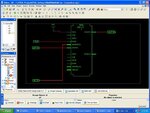prakashvenugopal
Advanced Member level 1
Hi,
I have to fill a RAM 256x8 using VHDL
ADDRESS : 00 to 256 with Data : 00 to 256
In the Address-->00, the data should be --> 00
In the Address-->01, the data should be --> 01
In the Address-->02, the data should be --> 02
In the Address-->03, the data should be --> 03
"
"
"
"
"
In the Address-->256, the data should be --> 256
Please let me know.
Regards,
V. Prakash
I have to fill a RAM 256x8 using VHDL
ADDRESS : 00 to 256 with Data : 00 to 256
In the Address-->00, the data should be --> 00
In the Address-->01, the data should be --> 01
In the Address-->02, the data should be --> 02
In the Address-->03, the data should be --> 03
"
"
"
"
"
In the Address-->256, the data should be --> 256
Please let me know.
Regards,
V. Prakash
